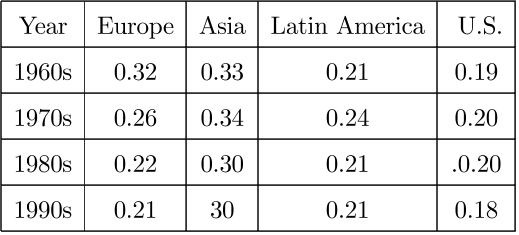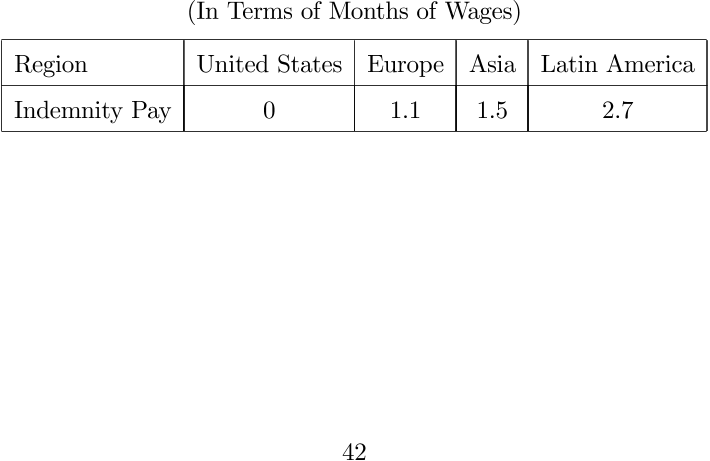Latin America in the rearview mirror
Harold L. Cole,Harold L. Cole,Lee E. Ohanian,Lee E. Ohanian,Lee E. Ohanian,Alvaro Riascos,James A. Schmitz +6 more
Reads0
Chats0
TLDR
This paper found that Latin American countries are the only Western countries that are poor and that are not gaining ground on the U.S. due to TFP differences, and that this failure is not plausibly accounted for by human capital differences, but rather reflects inefficient production.About:
This article is published in Journal of Monetary Economics.The article was published on 2005-01-01 and is currently open access. It has received 179 citations till now. The article focuses on the topics: Latin Americans & Total factor productivity.read more
Figures

Table 6. Investment-to-Output Ratios by Region (Regional Averages for Selected Countries) 
Table 4. Employment Rates by Region (Regional Averages for Selected Countries) 
Table 7. Bils-Klenow Relative Human Capital Levels (Regional Averages for Selected Countries, U.S. = 100) 
Table 5. Capital-to-Ouput Ratios by Decade Average Relative to the U.S.* 
Table 10. Government Ownership Share of the Top 10 Banks 
Table 11. Mandated Severance Pay
Citations
More filters
Posted Content
Threatening to increase productivity
TL;DR: In this article, the authors studied the productivity of Brazil's state-owned oil company Petrobras and found that the threat of competition and privatization was sufficient to generate large productivity gains.
Posted Content
Human Capital, Innovation, and Productivity Growth: Tales from Latin America and Caribbean
TL;DR: In this paper, the authors investigate the reasons behind the economic stagnation of Latin American and Caribbean countries for the past four decades and utilize a nonparametric Malmquist productivity index for relevant cross-country and over time productivity growth, technological change, and technical efficiency change comparisons.
Journal ArticleDOI
Growth and Reforms in Latin America: A Survey of Facts and Arguments
TL;DR: In this paper, the authors present a number of facts about growth in Latin America, and show how critical correlates of growth have evolved over time, including macroeconomic volatility, lower openness, and higher income inequality.
Journal ArticleDOI
Macroeconomic Volatility; The Policy Lessons from Latin America
TL;DR: The recent recovery in Latin America has been impressive but also raises the question whether this represents a fundamental break with the region's history of boom-bust cycles as discussed by the authors, and the role played by policy instability.
References
More filters
ReportDOI
Economic Growth in a Cross Section of Countries
TL;DR: For 98 countries in the period 1960-1985, the growth rate of real per capita GDP is positively related to initial human capital (proxied by 1960 school-enrollment rates) and negatively related to the initial (1960) level as mentioned in this paper.
Journal ArticleDOI
Why Do Some Countries Produce so Much More Output Per Worker than Others
TL;DR: This paper showed that differences in physical capital and educational attainment can only partially explain the variation in output per worker, and that a large amount of variation in the level of the Solow residual across countries is driven by differences in institutions and government policies.
Journal ArticleDOI
Why do Some Countries Produce So Much More Output Per Worker than Others
Robert E. Hall,Charles I. Jones +1 more
TL;DR: This article showed that the differences in capital accumulation, productivity, and therefore output per worker are driven by differences in institutions and government policies, which are referred to as social infrastructure and called social infrastructure as endogenous, determined historically by location and other factors captured by language.
Journal ArticleDOI
Technology, Geography, and Trade
Jonathan Eaton,Samuel Kortum +1 more
TL;DR: This article developed a Ricardian trade model that incorporates realistic geographic features into general equilibrium and delivered simple structural equations for bilateral trade with parameters relating to absolute advantage, comparative advantage, and geographic barriers.
Journal ArticleDOI
The Regulation of Entry
TL;DR: In this article, the authors present new data on the regulation of entry of start-up firms in 85 countries, covering the number of procedures, official time, and official cost that a startup must bear before it can operate legally.
Related Papers (5)
Why do Some Countries Produce So Much More Output Per Worker than Others
Robert E. Hall,Charles I. Jones +1 more